Hakone is a town in Kanagawa prefecture just west of Tokyo. The town is a part of the Fuji-Hakone-Izu National Park and is incredibly popular for its natural beauty and hot springs. What you may not know is that Hakone is also famous for pirate ships, hiking, and even an art gallery! Our Hakone area guide will let you know of all the must-see spots in Hakone.
What you can do in Hakone
Here are just a few of the things you could try in Hakone:
- Soak in hot spring baths overlooking the famous Lake Ashinoko,
- Ride high in the sky across a volcanic valley with the Hakone Ropeway,
- Admire the works of internationally renowned artists in an open-air museum, and more!
We will go into more detail about these sightseeing spots and more in Hakone, so be sure to read on!
Access
Limited Express Romancecar
From Tokyo, Hakone is easiest reached by train via Odakyu’s Romancecar. The Limited Express Romancecar runs between Shinjuku station and Hakone Yumoto station. This train takes just 75 minutes to reach Hakone from Tokyo, making it the fastest method. The Romancecar is run by Odakyu Electric Railway, so you will find the platform through the Odakyu gates in Shinjuku station.
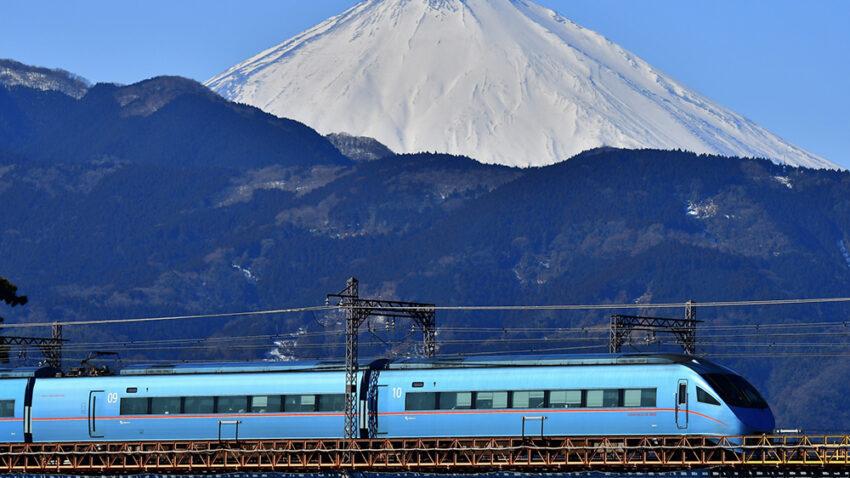
All of the seats on the Romancecar are reserved seats, so there is no need to worry about standing even during peak season. Sit back and relax on this beautiful train ride and watch outside as the scenery changes as you approach Hakone. If you have the chance, try to get tickets for the observation deck on the front or back car of the Odakyu 70000 series train. These cars have very large windows on the front and sides of the car that provide excellent viewing of the changing landscape.
Shinkansen
The shinkansen (bullet train) is another way to get to the Hakone area. While slower than the Limited Express Romancecar, the shinkansen is a cost-effective way to get to Hakone for Japan Rail Pass holders. The Japan Rail Pass covers the shinkansen journey between Tokyo and Odawara. From Tokyo or Shinagawa station you will board the west-bound Kodama or Hikari shinkansen. Once you arrive at Odawara station make your way to the Hakone Tozan Railway and get on the train bound for Hakone-Yumoto station, the terminus station.
If there is one thing to remember it’s that the Nozomi does not stop at Odawara station. You may end up in Nagoya if you take the Nozomi shinkansen instead of the Kodama or Hikari. Additionally, the Japan Rail Pass does not cover the Nozomi trains.
Hakone Freepass
If you want to explore the Hakone area and plan to use the train, ropeway, and bus, you should consider using the Hakone Freepass. The Hakone Freepass is a very useful transportation pass offered by Odakyu. With the pass, you get unlimited rides on the train, bus, ropeway, and even boats in the designated areas. You can choose to have a 2-day or 3-day pass depending on your travel plans in Hakone. Moreover, the Hakone Freepass covers your roundtrip train ride from Tokyo. You can even use the Romancecar from Tokyo if you just pay for the limited express ticket when using the Hakone Freepass!
この投稿をInstagramで見る
The Hakone Freepass is also feasible for those that plan on coming to Hakone by bullet train or to a destination other than Tokyo after they visit Hakone. You can buy the free pass at Odawara station at a slight discount without the roundtrip train from Tokyo.
Transportation in and around Hakone
Hakone Yumoto station is the gateway to the Hakone area. The station is centrally located in the main town area of Hakone and is the last stop of the Romancecar from Tokyo. There is a souvenir shop, cafe, and Hakone Tourist Information Center in the station. You can also leave the station to explore the area. Various restaurants, shops, and hot spring hotels are within walking distance of the station.
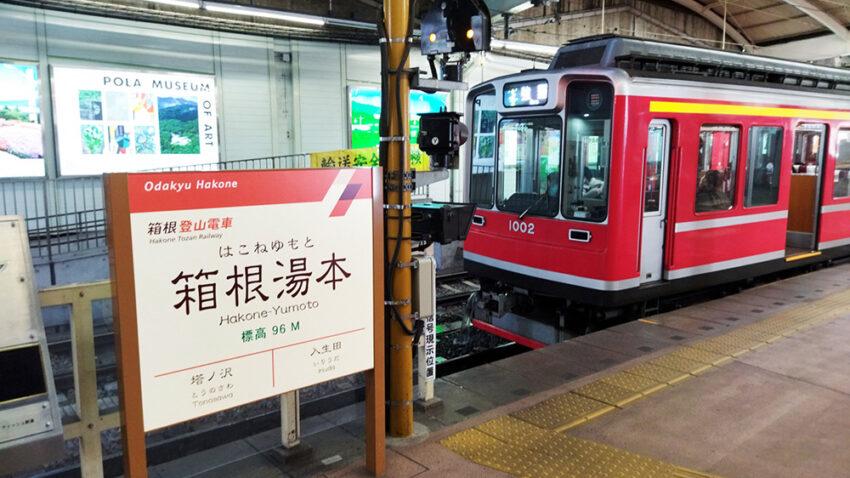
Additionally, you can transfer to the Hakone Tozan Line bound for Gora station at Hakone Yumoto station. The Hakone Tozan Railway was the first mountain railway in Japan. It climbs up the steep slopes in a zig-zag pattern by switching directions at 3 stations on the way to Gora station. Once you reach Gora station, you can transfer to the cable car. The cable car takes visitors to the Sounzan station where you can then transfer to the Hakone Ropeway.
The Hakone Tozan bus is also useful for reaching areas that are not serviced by the train, cable car, or ropeway. You can catch the Hakone Tozan buses from most of the Hakone Tozan Line stations, as well as Odawara station. We recommend using the Hakone Tozan bus and the railway and cable car together for the most efficient transportation.
Recommended sightseeing course
If you want to make the most of your time in Hakone, we recommend first taking the train from Hakone-Yumoto station to Gora station. From there, you can do some sightseeing before taking the cable car to Sounzan station. Sounzan station is the first stop on the ropeway, so get on here and get off at Owakudani where you can look at some volcanic activity before taking the ropeway again to Togendai station. Togendai station is located on the northern side of Lake Ashinoko. You can take one of the two cruises around the lake from Togendai to Hakone-machi where you can walk to Moto-Hakone (old Hakone). When you finished looking around Moto-Hakone take the bus back to Hakone-Yumoto station or make a pitstop on the way back.
This sightseeing course allows you to take advantage of the various methods of transportation and is efficient for sightseeing. The course is doable in one day if you leave Tokyo early enough, but we would recommend staying for one night so you are not in a rush. Experiencing the famous hot springs is another reason why a night in Hakone is a good idea!
Here are some maps to help you get around Hakone:
- Hakone area map in English to see the greater Hakone area. This is good for visualizing the route you want to take for sightseeing.
- Lake Ashinoko map in English to see the Lake Ashinoko area. Definitely take a look if you plan on stopping by this beautiful lake.
- Hakone-Yumoto map in English to see more details about the area around Hakone-Yumoto station. If you plan on shopping or staying the night at Hakone-Yumoto station, this map is for you! Accommodations, restaurants, and souvenir shops in Hakone-Yumoto are on the map.
More maps in English can be found here.
What to see in Hakone
The Hakone Open-Air Museum(箱根彫刻の森美術館)
The Hakone Open-Air Museum is an open-air art gallery located about 2 minutes on foot from Chokokunomori station on the Hakone Tozan Railway. Here you will find various sections of modern art and sculptures scattered throughout the inside of the museum. On the lawn outside, there are many sculptures created by both international and domestic artists.
この投稿をInstagramで見る
One of the most appealing points of the Hakone Open-Air Museum is that you can walk around and enjoy the different pieces of artwork while enjoying the natural beauty of Hakone. Mountains are visible from the museum and create an incredible backdrop. Although it is clear that the pieces of artwork are thoughtfully chosen for the various sections of the museum, they manage to fit perfectly into the landscape. Additionally, the open-air aspect of the site means that visitors can also enjoy a different atmosphere depending on the season they visit the museum. A visit on a snowy winter day will surely give you a different impression than a bright summer afternoon.
Calling all art fanatics, the Hakone Open-Air Museum has a permanent exhibition called the Picasso Collection. Here you will find the museum’s collection of over 300 works by the legendary Pablo Picasso! A rectangular white building with “PICASSO” written in black is where the Picasso Collection can be found. Inside, there are three main sections: one with large paintings and tapestries, a ceramics area, and a section with smaller paintings and sculptures. Furthermore, you can learn all about his personal and professional life as the museum offers a complete biography of Picasso in both Japanese and English.
For those with children, do not fret, the museum is friendly for visitors of all ages! Many of the sculptures and displays are interactive, so you are allowed to touch and climb on them. Furthermore, there are multiple kid spaces including a zig-zag triangle art world that kids can play in.
Hakone Ropeway(箱根ロープウェイ)
Sky high among the mountains is the Hakone Ropeway. The ropeway connects Sounzan station on the Hakone Tozan Railway with Togendai station at the shore of Lake Ashinoko. The journey on the Hakone Ropeway takes about 30 minutes with a transfer at Owakudani station.
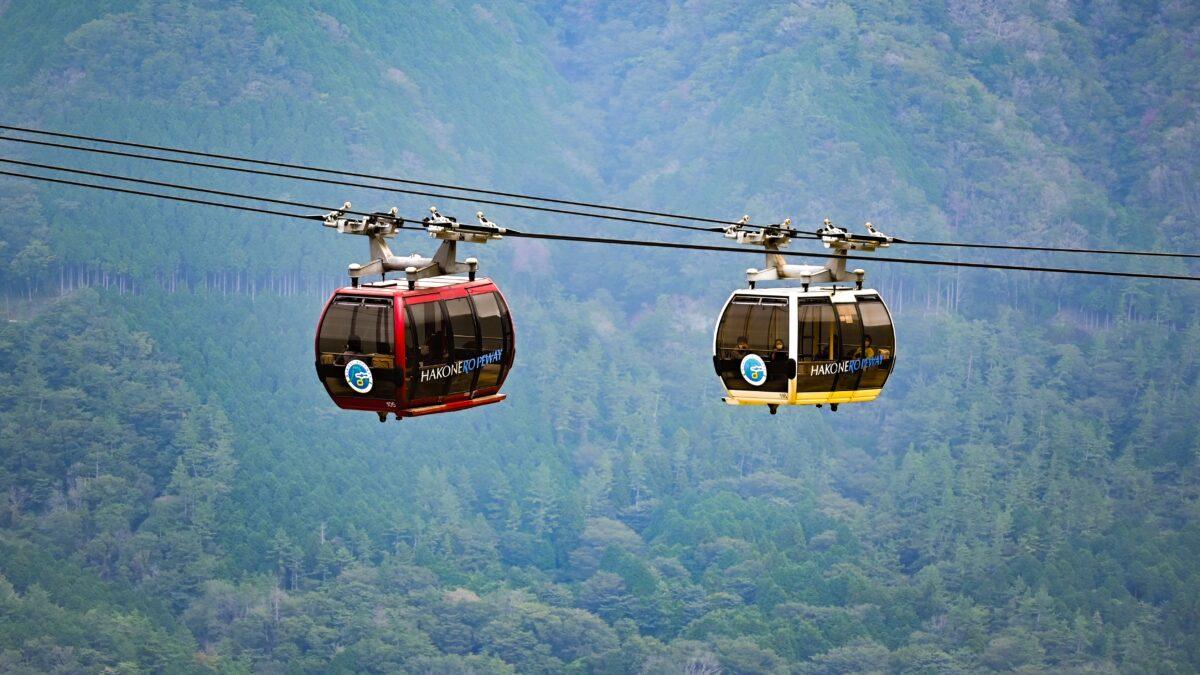
We recommend travellers take advantage of the transfer at Owakudani station and take a look at the active volcano zone. Once you get off at Owakudani station the smell of expired eggs will fill your nose. This is from the sulfurous mist that fills the air.
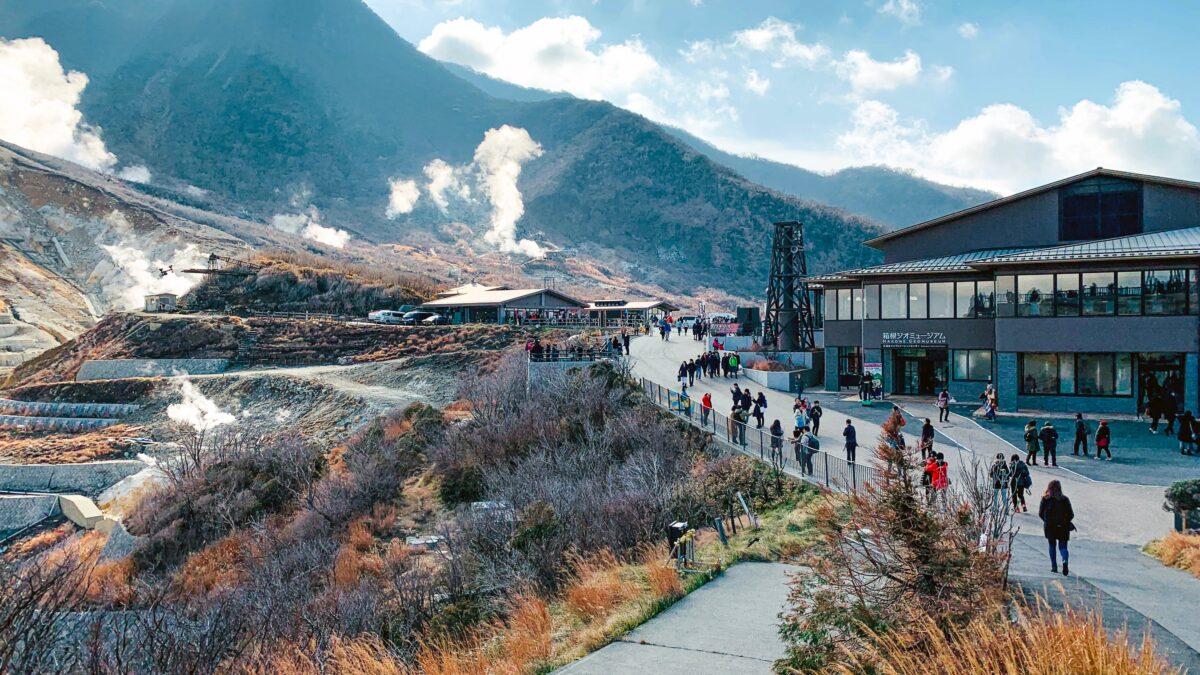
There is a souvenir shop at Owakudani called Kurotama shop, which means “black egg” shop in Japanese. Here you can purchase souvenirs and the famous black onsen eggs. The eggs are cooked in the hot spring pools at Owakudani, which is how their shell turns black. Legend says that eating one of the black onsen eggs will increase your lifespan by 7 years!
Please note that Hakone Ropeway occasionally closes when there is increased volcanic activity in the area. When ropeway service is suspended, bus service is offered between Sounzan and Togendai station instead.
Hakone Venetian Glass Museum(箱根ガラスの森美術館)
If you are looking for an original experience in Hakone differing from the usual sightseeing spots, then look no further than the Hakone Venetian Glass Museum! At the Hakone Venetian Glass Museum, there are Italian-styled buildings and gardens in addition to the museum.
The Hakone Glass Museum has two sections: The Venetian Glass Museum and the Modern Glass Museum. Between the museum’s two sections there are over 100 pieces of glassware. In addition to the museum, there is a nice garden with glass sculptures.
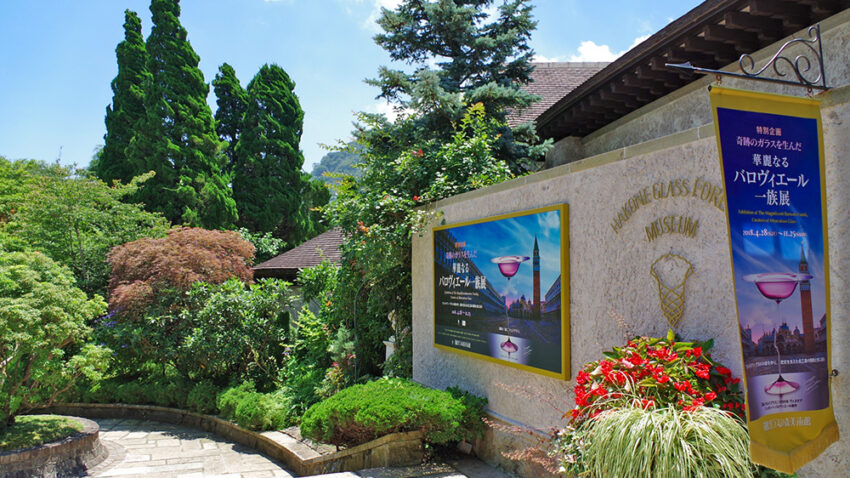
At the museum, there are two workshops you can take part in. You can try sandblasting or create a unique accessory. Kids are also welcome to take part in the workshops. It is not every day that you can try making your own glass creation!
Before leaving the museum stop at Cafe and Ristorante La Canzone for a snack or drink. Once an hour from 11 AM to 4 PM, you will be serenaded by a live music performance on the cafe’s terrace.
Lake Ashinoko
Lake Ashinoko is a beautiful lake in the middle of Hakone. The lake was formed 3000 years ago after Mount Hakone last erupted, and today remains a symbol of Hakone. When the weather is clear, Mount Fuji is visible in the background of Lake Ashinoko from certain parts of Hakone. Besides offering natural beauty, there are many activities to enjoy at Lake Ashinoko.
As you approach Lake Ashinoko, you may notice some ships cruising the lake. Two boat companies that operate on Lake Ashinoko: Hakone Sightseeing Boats and Izuhakone Sightseeing Boats. Both cruise companies transport tourists between the northern and southern shores of Lake Ashinoko. The Hakone Sightseeing Boats look like pirate ships and are exciting for children. Meanwhile, Izuhakone Sightseeing Boats operates the pleasure boat which goes all the way to Kojiri port on the north shore of Lake Ashinoko.
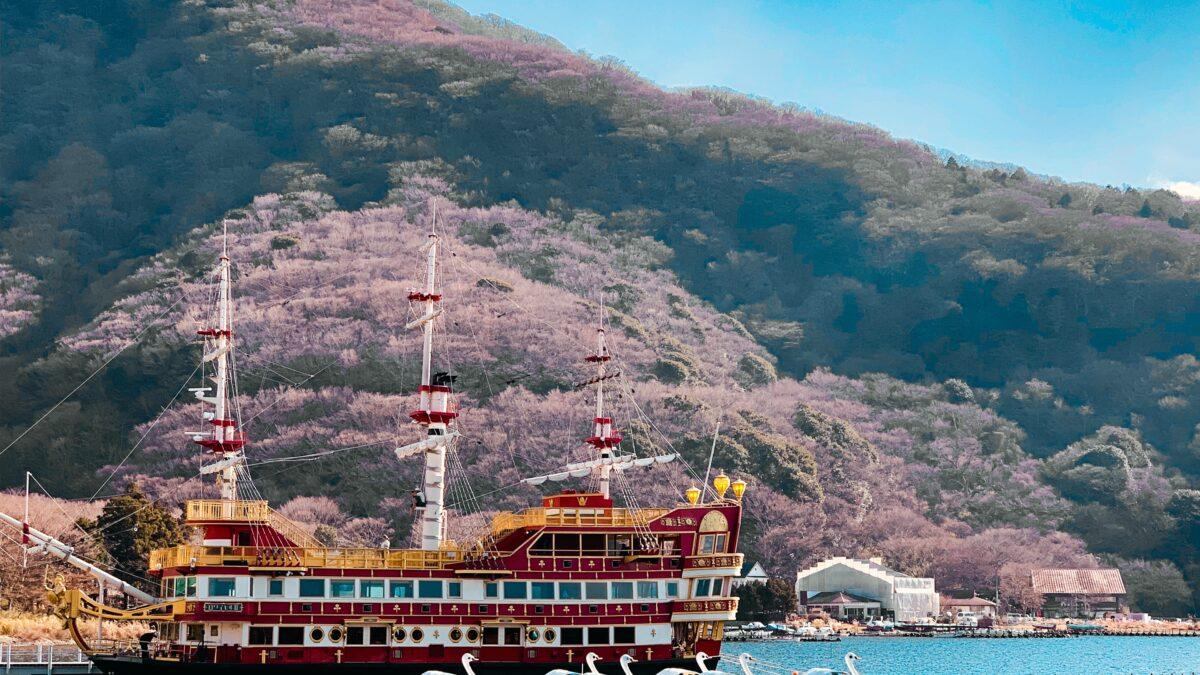
By the way, the Hakone Freepass is valid for use on the Hakone Sightseeing Boats but not the Izuhakone Sightseeing Boats.
Hakone Checkpoint(箱根関所)
Hakone Checkpoint was a security checkpoint between Moto-Hakone and Hakone-machi on the shore of Lake Ashinoko during the Edo Period in Japan. The Tokugawa shogunate, which was the samurai government of Japan at that time, created the Hakone Checkpoint. If you look at an old map, you will see that Hakone was located along the Tokaido, the old highway that linkedKyoto and Tokyo during the Edo Period. The Tokaido was one of the Edo Five Routes, which were significant corridors connecting Edo (now Tokyo) to the rest of Japan. As you can imagine, the checkpoint in Hakone was a convenient spot to control traffic. Additionally, it helped the shogunate prevent any unwanted visitors from making their way to the capital.
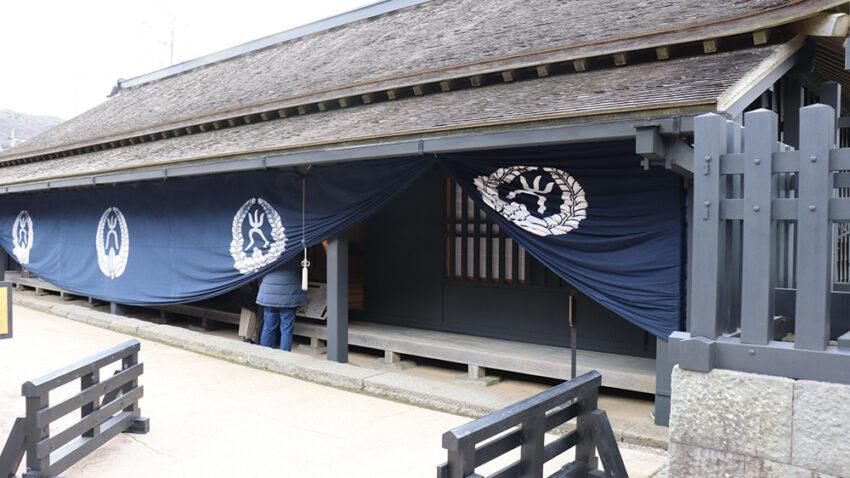
Although there is no need for such a security checkpoint now, the spot remains a reminder of what Japan used to be like during the Edo period. In recent years, the Hakone Checkpoint was renovated to resemble its original form. If you visit today, you will see gates, housing for officials, a prison chamber, and even a lookout tower – just like how it was 400 years ago!
Kyu-Kaido Trail
Between Moto-Hakone and Hakone-Yumoto remains part of the old Tokaido, also known as Kyu-Kaido. Even today you can walk along the old path that people travelled 400 years ago. In some parts, the original stone pavement even remains today! It is not every day that you can walk on the very same stones that a villager or maybe even a samurai walked along in the Edo period. The best-preserved parts of the Kyu-Kaido path are between Moto-Hakone and Hatajuku.
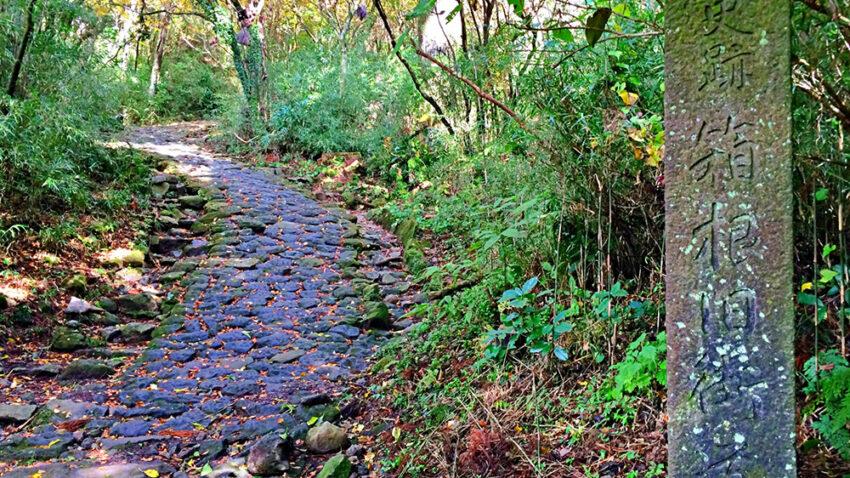
Along the way is a small tea house called Amazake Chaya. Here they serve amazake, which is a sweet rice wine with little to no alcohol content. Traditionally, amazake is a summer drink. During the Edo Period, people would cold drink amazake to cool off on hot summer days. However, the drink is also very popular during the winter months when it is served warm. Amazake Chaya serves both hot and cold amazake depending on the season. You can also try different kinds of Japanese snacks here such as mochi, konjac balls, and tokoroten. Why don’t you stop here and fill up on some snacks before departing to your next destination?
Nearby is the Kyu-Kaido Rest Area which has a small museum with displays of dioramas depicting life during the Edo Period. The museum is right next door to Amazake Chaya. We recommend this spot if you want to see displays of Japan’s interesting history. Plus, entry to the museum is free!
Hakone Shrine(箱根神社)
Hakone Shrine is a Japanese Shinto shrine standing at the foot of Mount Hakone on the shore of Lake Ashinoko. The shrine is said to be home to the Great Deities of Hakone. Hakone Shrine was originally founded on the top of the Komagatake peak in the year 757. However, the shrine was later relocated to its current location by Lake Ashinoko in 1667. The shrine has been incredibly popular throughout history and remains one of the most notable sights in the Hakone area.
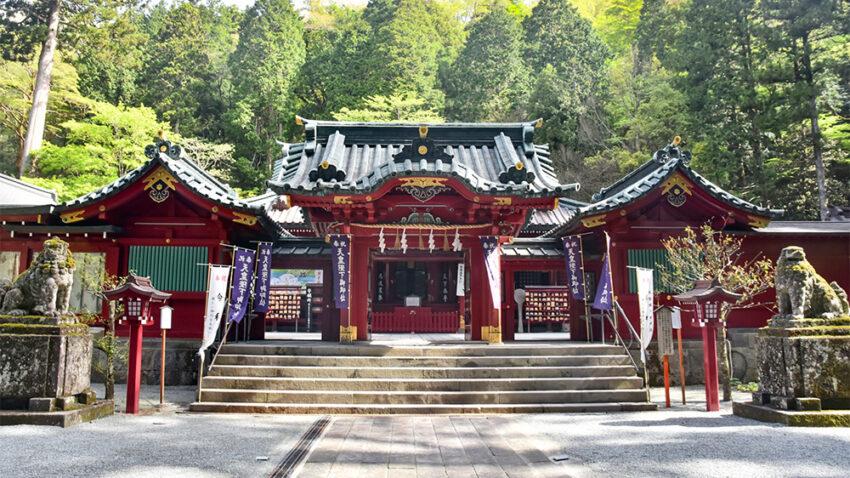
The shrine itself is deep in the forest, but you can easily find it by following the huge torii gates on the street. Two torii gates stand along the main street in Moto-Hakone, the small town area at the edge of Lake Ashinoko. The third and most notable torii gate stands on the edge of the lake. As you may expect, the third torii gate is incredibly popular for all visitors to Hakone and makes for a great selfie spot. We recommend taking a photo here up close with the shrine, as well as on the shores from Moto-Hakone. You can capture the bright red torii gates with Mount Fuji in the background with your camera.
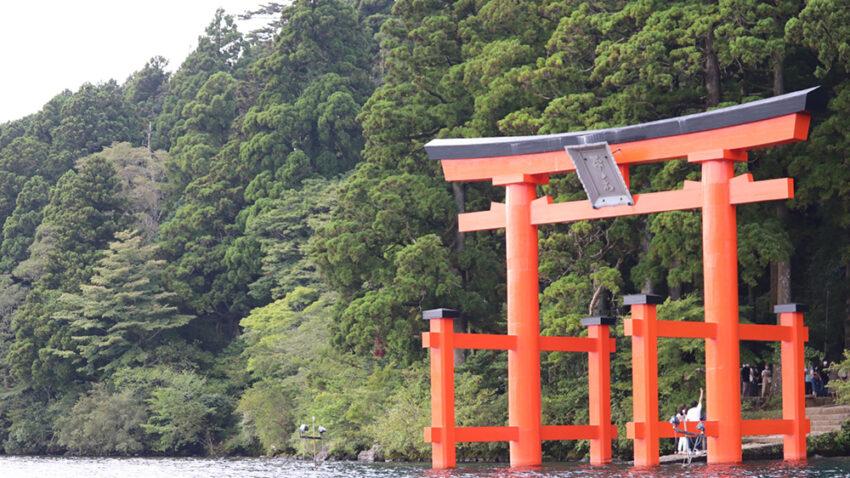
Kuzuryu Shrine Hongu(九頭龍神社 本宮)
Another shrine called Kuzuryu Shrine Hongu is located about 3.5 km north of Hakone on the shore of Lake Ashinoko. This shrine is deeply connected to Hakone Shrine and even has an annex called Kuzuryu Shrine Shingu within the Hakone Shrine complex. The water coming out of this fountain is a popular souvenir with many visitors taking some of the water in a plastic bottle.
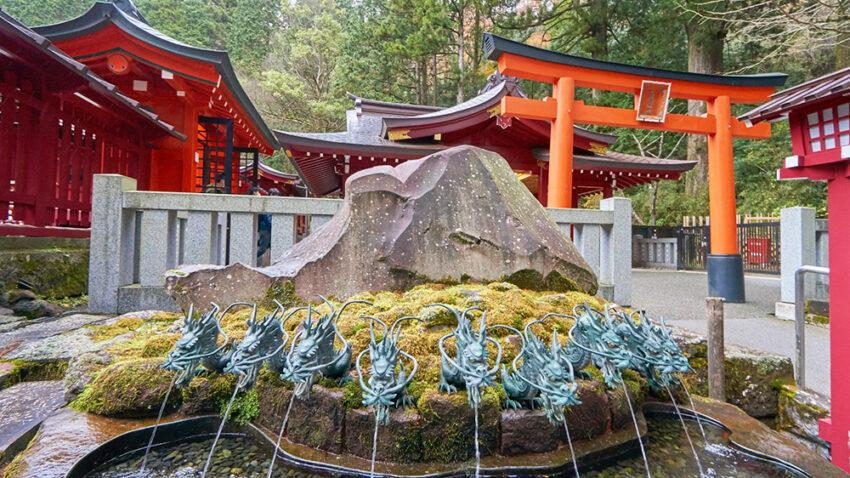
The name “Kuzuryu” refers to an ancient nine-headed dragon that used to haunt the villagers of Hakone until a monk with the powers granted by the Great Deities of Hakone was able to change the dragon’s heart. At Hakone Shrine you can see a fountain with water coming out of the nine heads of the dragon. Kuzuryu Shrine Hongu is popular for those looking for luck with their romantic lives. All you singletons out there, be sure to take the short hike to the shrine to get a boost of luck in your love life!
Hakone-en Resort Complex(箱根園)
Hakone-en is a resort complex on the eastern shore of Lake Ashi at the base of Mount Hakone. Hakone-en is home to the Hakone-en Aquarium, Komagatake Ropeway, as well as a variety of restaurants, shops, and activities. Although the park itself is affiliated with The Prince Hakone Ashinoko, anyone is allowed to enter Hakone-en. It is a one-stop shop for all of your entertainment needs in Hakone and is perfect for those visiting Japan with their family!
Activities
Hakone-en Aquarium is one of the main attractions of the complex. Did you know that the aquarium is the highest standing aquarium in Japan in terms of altitude? Here you can see both fresh and saltwater fish. Besides looking at the tanks of fish, visitors should stay for the seal show outside. Animal lovers would also want to try the otter handshake experience or make a visit to the petting zoo.
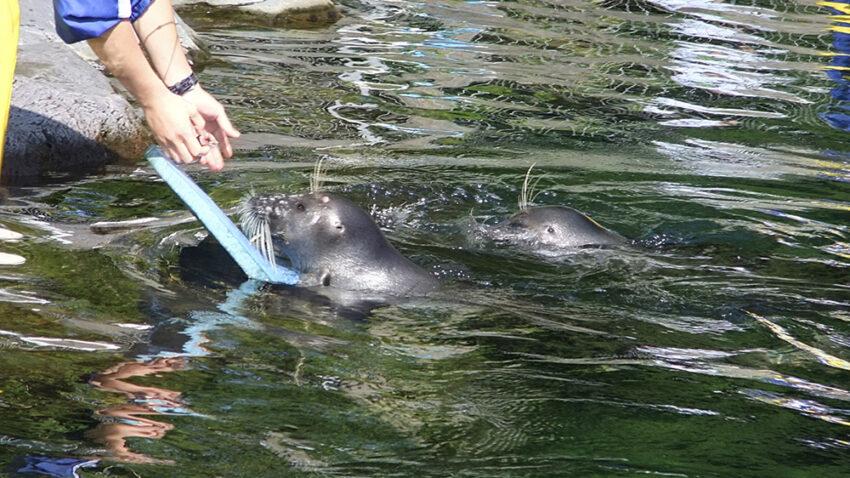
Another attraction at Hakone-en is the Ninja-bus! This large black bus takes passengers around Hakone-en. Starting on the street beside the aquarium, the Ninja-bus runs straight toward the shore of Lake Ashinoko and goes into the lake! The Ninja-bus turns into a boat and takes passengers on a short cruise around the lake before heading back to shore.
If you want to experience Japanese culture, why not head inside for some workshops? You can try to rakuyaki pottery, which is commonly used for making tea wares. Make a one-of-a-kind plate or cup with special paints! Alternatively, you can make a wooden coaster at the Yosegi Corner.
Hot springs
Since you are already in Hakone, why not take a dip in the world-class hot springs? Ryuguden ryokan is a traditional Japanese inn within the Hakone-en park. You can come here for day use of the hot springs. The ryokan is famous for its baths which offer panoramic views of Lake Ashinoko. If the skies are clear, you may even get to see Mount Fuji behind the mountains that surround Hakone. If you are feeling worn out from a day of sightseeing, you can also stay overnight at Ryuguden.
Hakone Kowakien Yunessun(箱根小涌園ユネッサン)
Hakone Kowakien Yunessun is a super fun hot spring theme park located near Kowakidani station on the Hakone Tozan Railway. There are a variety of things to enjoy during a visit to the park, including spas, hot spring baths, restaurants, and massages. Visitors come here to enjoy the interesting and rare hot spring baths mixed with various foods you might be familiar with, as well as the traditional Japanese-style baths. Take some time to refresh yourself while enjoying the natural beauty of Hakone that surrounds the resort.
Yunessun Area
At Hakone Kowakien Yunessun, there are a total of 23 baths both indoors and outdoors. You might be expecting your typical indoor pool-type situation, but that would be too boring! Here at Yunessun, there are many interesting baths such as a coffee bath made with real coffee beans, a wine bath (no drinking allowed, in case you were wondering), and more. There is even a bath called the Dr. Fish foot bath. You can dip your feet in the water for the most unique spa experience ever. Tiny tropical fish in the water will nibble at your feet, eating away the dead skin and leaving your toes feeling super smooth!
この投稿をInstagramで見る
Mori no Yu
The Mori no Yu area is the hot spring area that represents traditional Japanese hot spring baths. A beautiful open-air bath allows you to relax in the hot spring baths while relishing Hakone’s natural beauty. There are some indoor hot spring baths too, such as a bath made of cypress (for women only) and some outdoor tubs made out of Japanese pottery.
In addition to the numerous baths are the Finnish sauna, aroma room, and warm stone room. You can also arrange to get a massage at Oriental Massage Salon Herb. Please note that the massages are only available to Mori no Yu guests.
Some foreign visitors might feel a bit shy when they hear that they have to enter a Japanese hot spring bath naked. This is not a problem at Yunessun, as the resort requires visitors to wear a bathing suit in the Yunessun area. If you forgot to pack your bathing suit you can rent or buy one at ukiuki on the 4th floor of the building. Please note that the Mori no Yu area requires all patrons to remove all clothing, which may be suitable for the more adventurous. If you want to try the authentic Japanese hot spring experience without the fear of strangers, there are also private rooms with hot spring baths that you can enjoy with your family or friends. Tattooed guests are also welcome to use the reservable private rooms with baths.
For those coming to Hakone Kowakien Yunessun as a family, there are a few attractions that are sure to entertain the kids in the outdoor area. The Rodeo Mountain Slide has 3 waterslides. Try sliding down each one to compare the twists and turns. As a family, you can also play together at BOXAPPY’s Jungle Gym.
Outside of the baths
After relaxing in the baths, complete your day with a visit to one of the many restaurants located on-site. If you feel like trying some authentic Japanese cuisine, fill your stomach up with some teppanyaki! Enjoy watching the freshest meat and vegetables being cooked in front of your eyes by a professional chef. Alternatively, head to Hakone Kowakien Daimonji Terrace for Hawaiian-inspired one-plate meals.
For those who want to make the trip to Hakone Kowakien Yunessun an overnight trip, consider staying at one of the four official hotels in the area.
Accommodation
Hakone has many accommodations. You have the option to stay in a hotel or experience true Japanese hospitality at a ryokan. Read on for our recommendations!
Hanaori
Overlooking Lake Ashinoko is Hanaori, a modern hot spring hotel. The rooms are equipped with comfortable twin beds and have a clean modern interior. If sleeping on the floor turns you off, consider Hanaori the answer to your problems! Furthermore, a beautiful lounge area on the terrace is the perfect place to relax. The lounge seats are surrounded by water and overlook Lake Ashinoko.
この投稿をInstagramで見る
Hanaori has amazing hot spring baths. Separated by gender, these baths have beautiful views of Hakone’s landscape. There are two outdoor baths: one with a view of the garden, and one with a view of Lake Ashinoko.
Both breakfast and dinner are offered on a buffet basis, so you can choose to eat what you like. For dinner, enjoy Japanese and French dishes made with fresh seasonal ingredients. Also, there are both Japanese and Western options for breakfast.
The Prince Lake Ashinoko
Another option for accommodation is The Prince Lake Ashinoko. The Prince Lake Ashinoko is beside Hakone-en; super convenient for anyone spending the day at the park. When the weather is clear, you can even see Hakone from the hotel gardens.
Some rooms have views of Lake Ashinoko or Mount Fuji. Imagine waking up to see the amazing snow-capped peak of Mount Fuji! Also, the rooms are all equipped with Western-style beds and are quite large, which are suitable for foreign visitors.
Now that you know all about Hakone, it is time to make a plan to visit! Talk to us here at Tokyo Travel Assist about how you plan to visit the beautiful hot spring town. Tokyo Travel Assist can also help you get around Hakone.
